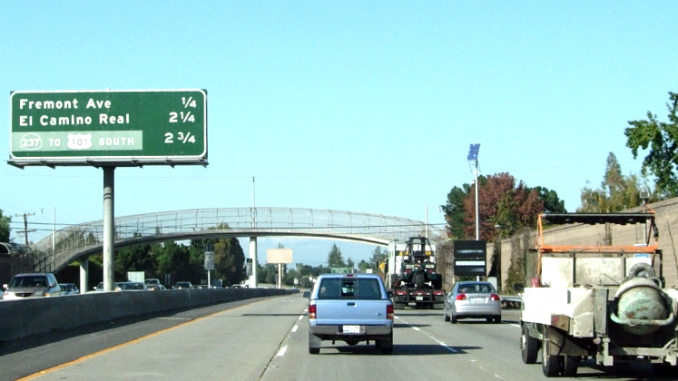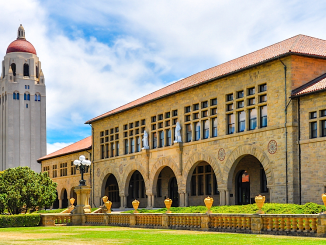
BY ALLISON LEVITSKY
Daily Post Staff Writer
VTA is seeking to extend the hours during which drivers have to pay a toll to use express lanes — and to start charging drivers of electric cars and two-person carpoolers to use the lanes.
Mountain View Mayor Lenny Siegel, who learned about the ordinance at a VTA Policy Advisory Committee on Thursday (Sept. 13), said he was “kind of shocked” by the proposal and concerned that the new enforcement rules are being snuck by the public.
“If this is adopted, people who live here — not people who live in Fremont or Modesto — will learn about this when they put in the toll lanes here, and probably no sooner,” Siegel told the Post, noting that he only speaks for himself, not the City Council.
Saratoga Councilman Howard Miller, who chairs the committee, also raised concerns about VTA bringing forward such significant changes while leaving the public “virtually unaware that these changes are going on.”
Siegel said the Metropolitan Transportation Commission was pushing similar rules in different Bay Area counties so that there’s uniformity on the highways.
Tolls up to $8
Miller noted that 500 miles of Bay Area carpool lanes will be converted into express lanes over the next five years. Drivers use FasTrak devices to pay the toll. In Santa Clara County, the toll can vary between 30 cents and $8 based on traffic.
“Name a freeway, and they’re pretty much converting the carpool lanes into express lanes,” Miller said.
The express lanes on Highway 237 currently operate weekdays in two shifts: from 5 a.m. to 9 a.m. or 10 a.m., and 3 p.m. to 7 p.m. That means drivers get a five- to six-hour break in the middle of the day when the lanes go back to being carpool lanes.
The new ordinance would get rid of that midday break and charge drivers to use the lanes from 5 a.m. to 8 p.m. weekdays.
That’s not the only proposed change. Currently, drivers of “clean-air vehicles,” including hybrids and electric cars, can use carpool lanes even when driving alone. Under the proposed VTA ordinance, drivers of such cars would have to pay half the toll.
Siegel said the special carpool allowance had been an “extremely effective tool” in getting people to buy electric cars and hybrids. The new rules would take that incentive away, he said.
“They call it a discount, but they’re basically applying a toll for the first time for those cars,” Siegel said.
Miller said there’s some precedent for charging clean air vehicles half the toll on the Bay Bridge.
Both Siegel and Miller own electric cars. Miller said he’s never put the Clean Air Vehicle sticker on his car because he thinks carpool lanes should be used for people to share rides, “not for people who buy the right kind of car and get a free pass.”
More than 80% of the people in the carpool lane on Highway 85 use the sticker, Miller said. On Highway 237, it’s 37%.
Two wouldn’t be enough
And two people in a carpool won’t be enough to avoid the toll. The new ordinance would charge those cars half the toll, only allowing carpools of three to use the lanes for free.
Miller sees this as a problem because of how much more difficult it is to coordinate commutes with two other people rather than one. Under the proposed ordinance, drivers would use their FasTrak transponders to indicate the number of passengers.
Siegel said he opposes toll lanes because they privilege the wealthy.
“I’m against using price as a way of allocating the roadways because I think it’s inequitable,” Siegel said.
The 12-member VTA board is made up of 10 City Council members and two members of the Santa Clara County Board of Supervisors.
“It’s an unelected board, and it’s making a decision that really comes out of the bureaucracy and not working with the constituents,” Siegel said.
Siegel contrasted the quiet VTA process with the public engagement process that the city of Mountain View undertook before putting a business tax on the November ballot.
“We went through a long series of meetings with the community, with our businesses, to make sure that people knew what was going on,” Siegel said. “I don’t know when VTA has ever done that. I sure missed it.”




We need to find some way to put this on the ballot! This would essentially have the effect of removing the lanes for which we have already paid from any usability for us–while taxing us hundreds of millions or billions of dollars to provision the ExpressLanes (estimated at about $600M for just on such recently proposed conversion in the news). We never drive before 5 AM and almost never drive after 8 PM, and we don’t traditionally “commute”, so we would, in essence, be denied the use of these lanes forever unless we pay a toll.
I filed a California Public Records Act request for any/all records relating to evaluating the performance of ExpressLanes vs using the same number of lanes for all general purpose lanes or a mix of general purpose and HOV lanes (with no Express Lanes). I only received one document, which was not responsive to the request in any meaningful way, therefore presumably showing VTA is blindly doing this without any real justifying evidence.
VTA is just empire-building–and wants a multi-billion $ budget boost to build its empire faster!